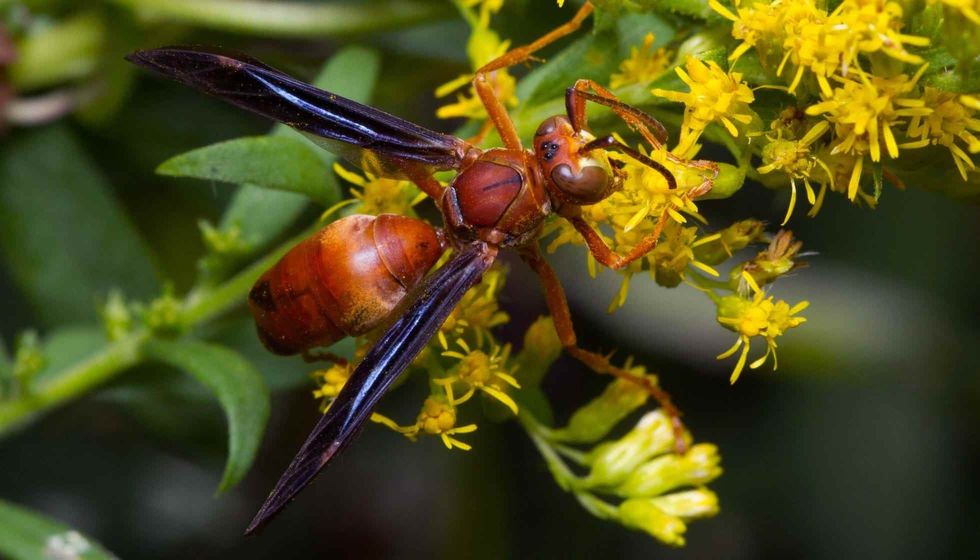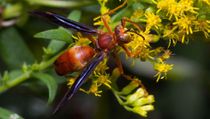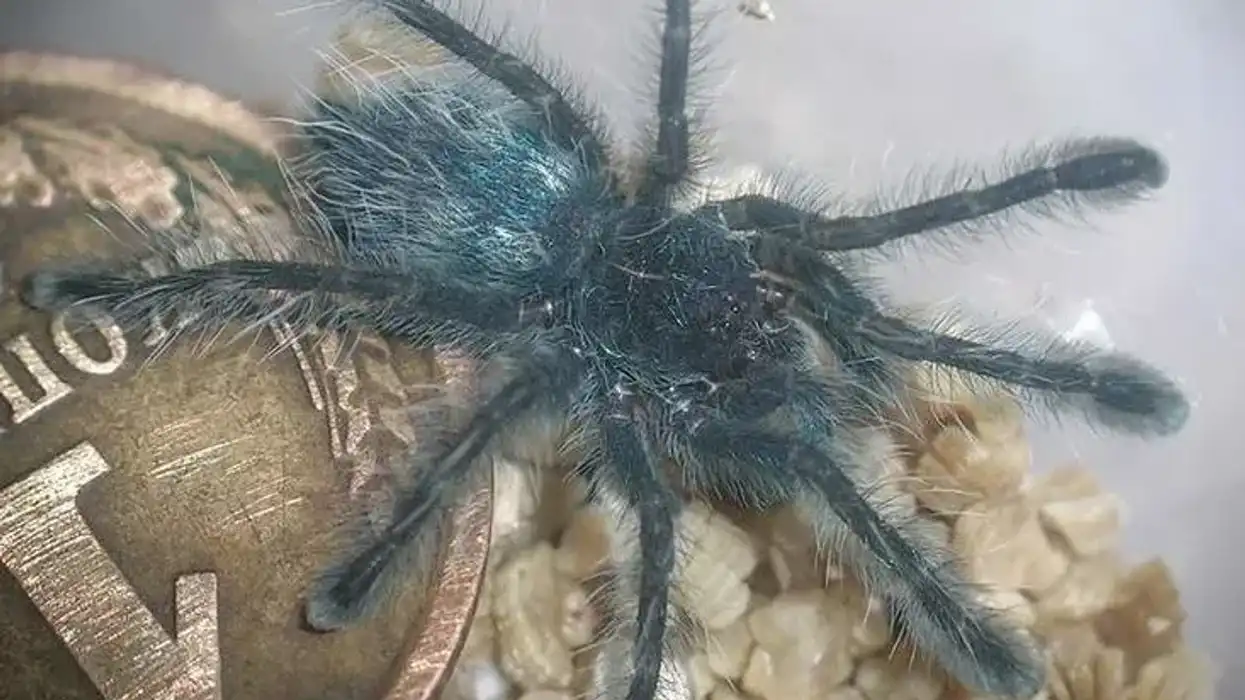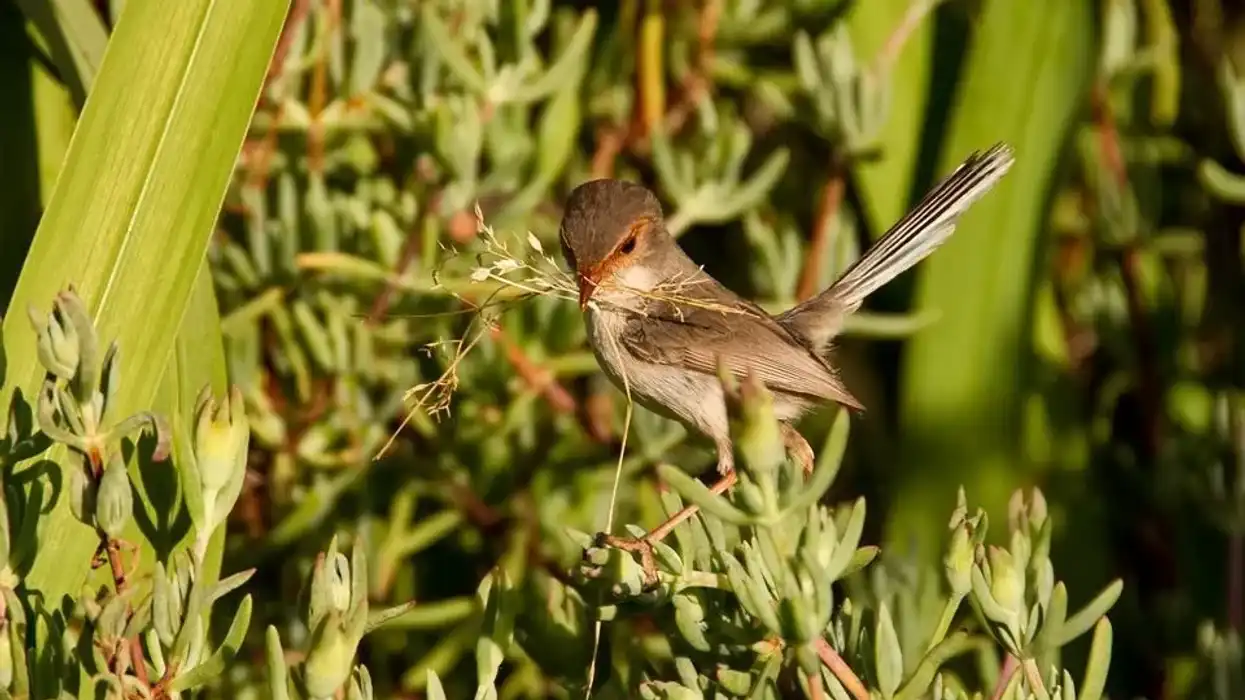Do you admire insects? Then, here we have an interesting one, that is the red wasp or red paper wasp.
The red paper wasp, Polistes Carolina, belongs to order Hymenoptera has a few different types of them. Fine-backed red paper wasp (Polistes carolina) and Neotropical red paper wasp (Polistes canadensis) are two of them. The red paper wasp range is in North and South America, in places like Texas of the United States, Brazil, Columbia, Ecuador, Argentina, and more.
They are brown to dark red-colored. They have purplish-black-colored wings and yellow-colored markings. They stay in nests and make up a colony of their own where they mostly have a queen and many worker wasps.
The larvae of these wasps eat chewed, liquefied insects and caterpillars, and the adults eat nectar from flowers and other insects. The wasps are not aggressive in nature unless they feel threatened by something.
Read on to know more about the red paper wasp and if you like this article then check out the mud dauber wasp and the yellow jacket wasp.
Red Paper Wasp Interesting Facts
What type of animal is a red paper wasp?
The red-headed paper wasp or red paper wasp is a type of paper wasp of the Polistes genus, which is an insect.
What class of animal does a red paper wasp belong to?
The red paper wasp falls under the class Insecta, order Hymenoptera, and family Vespidae of the Animalia kingdom.
How many red paper wasps are there in the world?
Though the Polistes canadensis is most commonly known as the red paper wasp, however, both species of the Polistes genus fall under the category of red paper wasp. However, since these species are very common, the exact number of red paper wasps is unknown.
Where does a red paper wasp live?
The red paper wasp is found in a wide range of countries that are specifically located on the continents of North America and South America. The majority of countries in which these insects inhabit are the United States, Brazil, Mexico, Peru, Colombia, Argentina, and other similarly located countries. These wasps build nests anywhere from open spaces to man-made structures.
What is a red paper wasp's habitat?
The habitat of this species is mainly confined to the neotropical regions of the planet. The neotropical region on earth is mainly concentrated in areas like Central America and South America.
Here in this type of climate, the temperature is mainly similar to those of the tropical climates however moderate climates which are found in grasslands are also found. The red paper wasps are known to build their nests in these climates.
They build their nests on open grasslands or in the hollow woods of trees. Some of these wasps are also known to live near human settlements as extensive paper wasp nests are found in human constructions like buildings or rooftops.
Who do red paper wasps live with?
In general, there are two distinct types of moths based on their behavior and settlements. The former is the solitary type that lives alone while the latter is the social type.
The social wasps live in large colonies where they stay and interact with one another. In the case of the red paper wasp, these insects belong to the second category and are therefore of the social type. The red paper wasp is known to live in large numbers in their colonies.
How long does a red paper wasp live?
These wasps take about 40 days to transform from eggs to adults, but the exact duration of their lifespan is not known. We can surely assume that like other wasps, their lifespan is rather short.
How do they reproduce?
When the red paper wasps stay in colonies, and if the colony has any queen, then the queens lay 60% of the eggs of the total brood. The other 40% of the eggs are laid by other fertile female workers in the colony.
If there are no reigning queens in the colony, the fertile female workers will lay the eggs.
The fertile females can mate with more males and the female who is more dominant lays more eggs than the others. If there are no queens in the colonies, the fertile females go on to form their own colony.
What is their conservation status?
The conservation status of the red paper wasp is Not Listed under the International Union for Conservation of Nature Red List. We can at least assume that since they breed in a large number and don't face any great threat, their population is stable.
Red Paper Wasp Fun Facts
What do red paper wasps look like?

Red paper wasps are large-sized wasps. They have a light red to brown body. Their thorax and head are of lighter color compared to the other parts of its body. They have purplish-black wings.
Sometimes they have yellow markings on their body and the last tergum of their body can have a blackish shade. They have two antennae coming out from the front of their head and have six total legs. The males and the females of the species look the same.
How cute are they?
They might look cute to the people who appreciate insects, but they can look scary to a large number of people too. A flying insect of their size with a fiery red color can certainly scare away many people.
How do they communicate?
Red paper wasps don't communicate verbally or visually, rather they communicate biologically. They release pheromones and by the sense of smell, the wasps communicate with each other.
The smell is undetectable by humans but easily detected by other insects and it helps them keep the predators away. It helps the wasps understand different messages from each other too, such as if a wasp is ready to mate, food sources, and more.
How big is a red paper wasp?
These wasps are relatively large in size and their length is about 0.5-1 in (12-25 mm). One of the largest wasps is the Asian giant hornet. They are about twice the size of the red paper wasps. The length of the Asian giant hornets is about 2 in (50.8 mm).
How fast can a red paper wasp fly?
Red paper wasps flutter their wings at a high speed, and sometimes they can stay suspended in the air while flying. They don't fly at a high speed though. Their flying speed is moderate at best. The exact speed at which they fly is still unknown.
How much does a red paper wasp weigh?
Since they are small insects, and due to not enough research done on the species, the exact weight of the wasps is not known. We can only assume that they may be of very lightweight.
What are their male and female names of the species?
There is no specific name for males or females of the species.
What would you call a baby red paper wasp?
The babies of the red paper wasps are called larvae.
What do they eat?
The juvenile red paper wasp or larvae of the species is given chewed insects like cicada and more, but mainly they are given caterpillars to eat by the adults. When they become adults, the red paper wasps feed on fruit juices, nectar from flowers, and sometimes they eat other insects too.
Are they poisonous?
They have very little venom and do not attack anyone unless they feel threatened in any way. If you get stung by the red paper wasp, the effect of their venom doesn't last very long and it only pains a little for a while.
If only someone is allergic to their venom, however, it can be dangerous to humans but there hasn't been any record of it killing anyone. They are not dangerous or aggressive to say in a conventional manner.
Would they make a good pet?
Wasps, flies, or any of the insects that thrive in the wild do not make good pets. It's difficult to keep them alive and in one place. They also should not be kept as pets.
Did you know...
About 300 different paper wasp species can be found around the world. Red and yellow paper wasps are two among the many species.
The red paper wasp nest is made with fibers that they collect from plant stems and wood. They then mix it with saliva and as a result, some paper-like brown or grey material is made and their nests are made by this. That's how they got their common name of the red paper wasp.
If you see a nest of red paper wasps somewhere near your house, it's better to not disturb them or try to get rid of them by yourself. It's better to call pest control.
Are paper wasps good for anything?
Red paper wasps can be good for society in a way. Caterpillars can harm many plants, and red paper wasps give their larvae caterpillars to eat. The adult red paper wasps also eat many harmful insects.
Where are red paper wasp nests commonly found?
Mostly the red paper wasp nests are found in grasslands or hollow woods of trees. The paper wasp nest can also be found in buildings, rooftops, sheltered areas, or on trees in gardens.
Many nests like these can be found around human establishments. Some of the paper wasp nest can also be seen in open pipes and in some burrows into the ground.
Here at Kidadl, we have carefully created lots of interesting family-friendly animal facts for everyone to discover! Learn more about some other arthropods including the cicada killer wasp and the common wasp.
You can even occupy yourself at home by drawing one of our Red paper wasp coloring pages.









